Performance Management Fundamentals: ADNOC Group Analysis Report
VerifiedAdded on 2022/09/09
|9
|1786
|11
Report
AI Summary
This report provides a comprehensive review of the Abu Dhabi National Oil Company (ADNOC)'s performance management system (PMS). The analysis includes an examination of ADNOC's organizational design, its current PMS, and the implementation of Oracle Talent Management Cloud. The report highlights the effectiveness of the PMS, which utilizes a balanced scorecard model and key performance indicators (KPIs), but also identifies areas for improvement, such as increasing transparency, frequency of reviews, and providing more development opportunities. The research is based on interviews and surveys with employees. Recommendations include using data analytics, performance management software like emPerform, and enhancing communication to improve the PMS. The report concludes that ADNOC can enhance its PMS through these strategic adjustments, ensuring alignment with organizational goals and employee development.
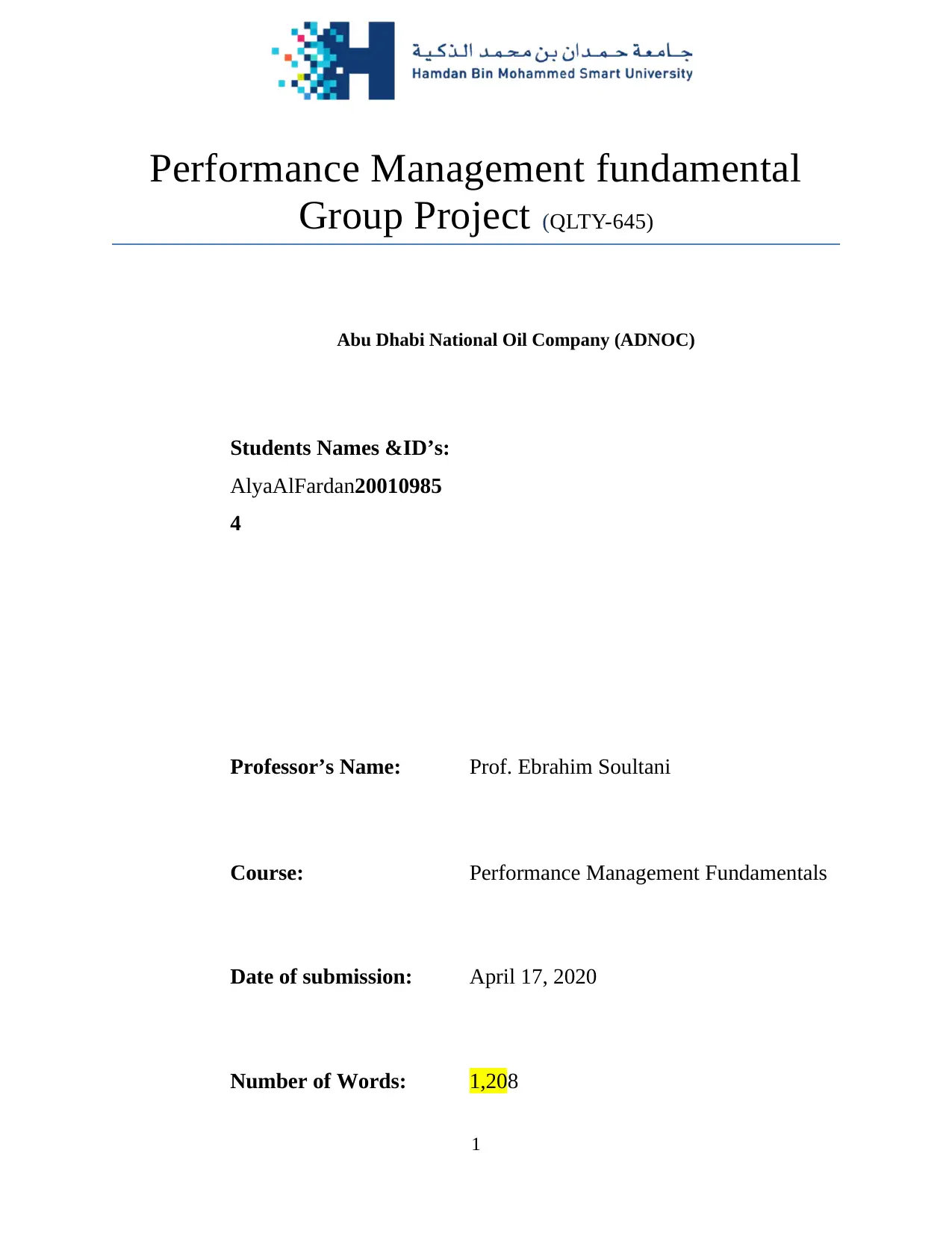
Performance Management fundamental
Group Project (QLTY-645)
1
Abu Dhabi National Oil Company (ADNOC)
Students Names &ID’s:
AlyaAlFardan20010985
4
Professor’s Name: Prof. Ebrahim Soultani
Course: Performance Management Fundamentals
Date of submission: April 17, 2020
Number of Words: 1,208
Group Project (QLTY-645)
1
Abu Dhabi National Oil Company (ADNOC)
Students Names &ID’s:
AlyaAlFardan20010985
4
Professor’s Name: Prof. Ebrahim Soultani
Course: Performance Management Fundamentals
Date of submission: April 17, 2020
Number of Words: 1,208
Paraphrase This Document
Need a fresh take? Get an instant paraphrase of this document with our AI Paraphraser
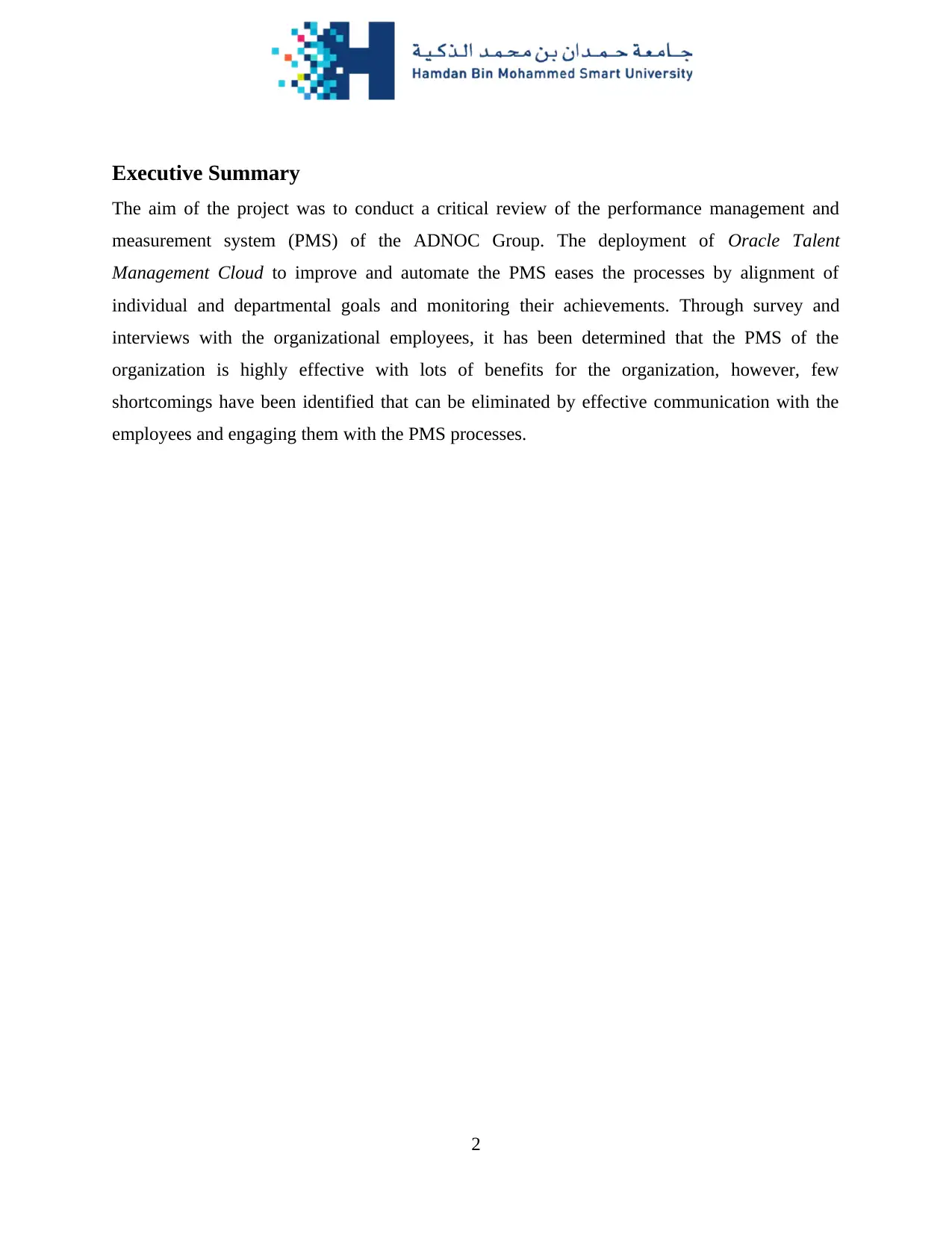
Executive Summary
The aim of the project was to conduct a critical review of the performance management and
measurement system (PMS) of the ADNOC Group. The deployment of Oracle Talent
Management Cloud to improve and automate the PMS eases the processes by alignment of
individual and departmental goals and monitoring their achievements. Through survey and
interviews with the organizational employees, it has been determined that the PMS of the
organization is highly effective with lots of benefits for the organization, however, few
shortcomings have been identified that can be eliminated by effective communication with the
employees and engaging them with the PMS processes.
2
The aim of the project was to conduct a critical review of the performance management and
measurement system (PMS) of the ADNOC Group. The deployment of Oracle Talent
Management Cloud to improve and automate the PMS eases the processes by alignment of
individual and departmental goals and monitoring their achievements. Through survey and
interviews with the organizational employees, it has been determined that the PMS of the
organization is highly effective with lots of benefits for the organization, however, few
shortcomings have been identified that can be eliminated by effective communication with the
employees and engaging them with the PMS processes.
2
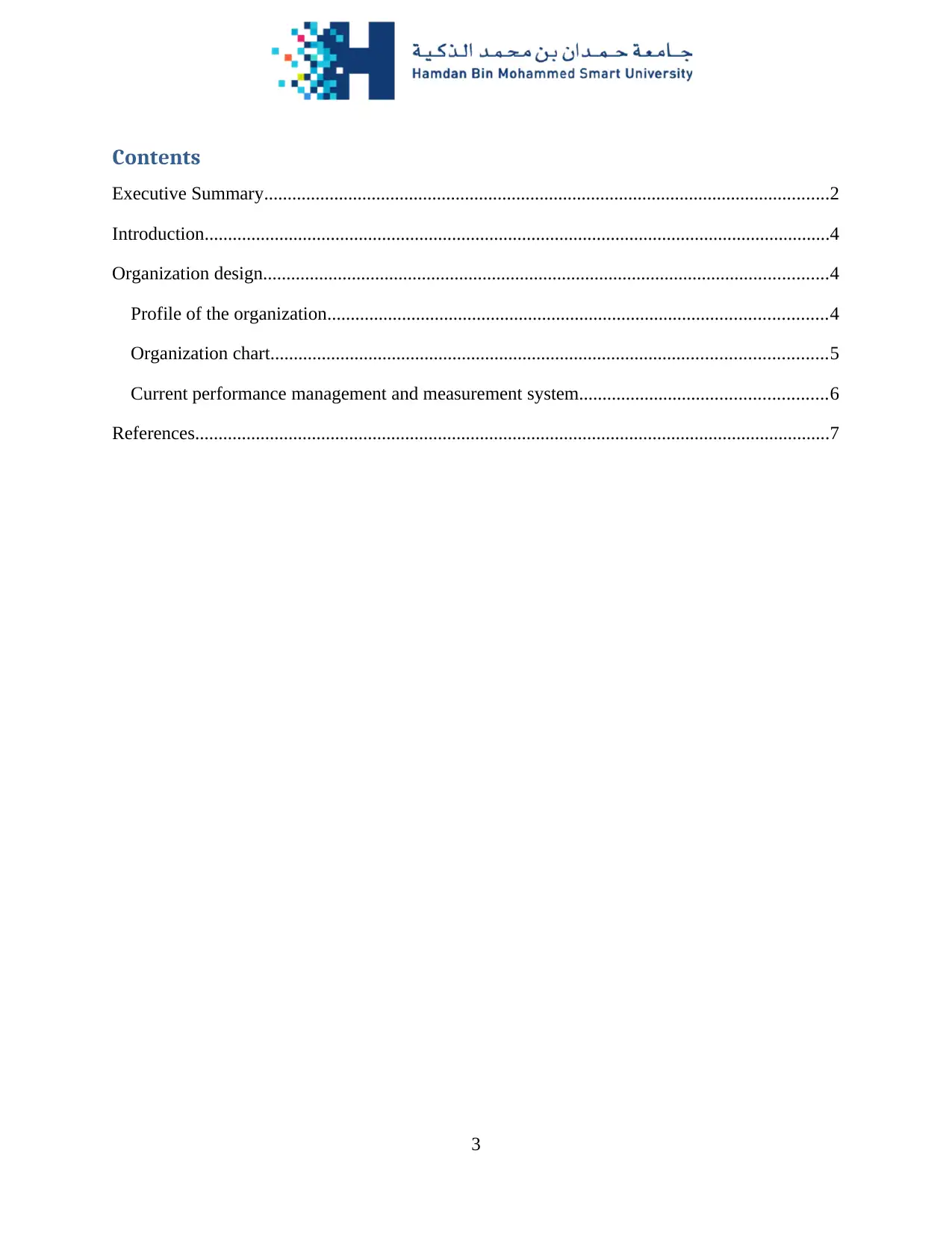
Contents
Executive Summary.........................................................................................................................2
Introduction......................................................................................................................................4
Organization design.........................................................................................................................4
Profile of the organization...........................................................................................................4
Organization chart.......................................................................................................................5
Current performance management and measurement system.....................................................6
References........................................................................................................................................7
3
Executive Summary.........................................................................................................................2
Introduction......................................................................................................................................4
Organization design.........................................................................................................................4
Profile of the organization...........................................................................................................4
Organization chart.......................................................................................................................5
Current performance management and measurement system.....................................................6
References........................................................................................................................................7
3
⊘ This is a preview!⊘
Do you want full access?
Subscribe today to unlock all pages.

Trusted by 1+ million students worldwide
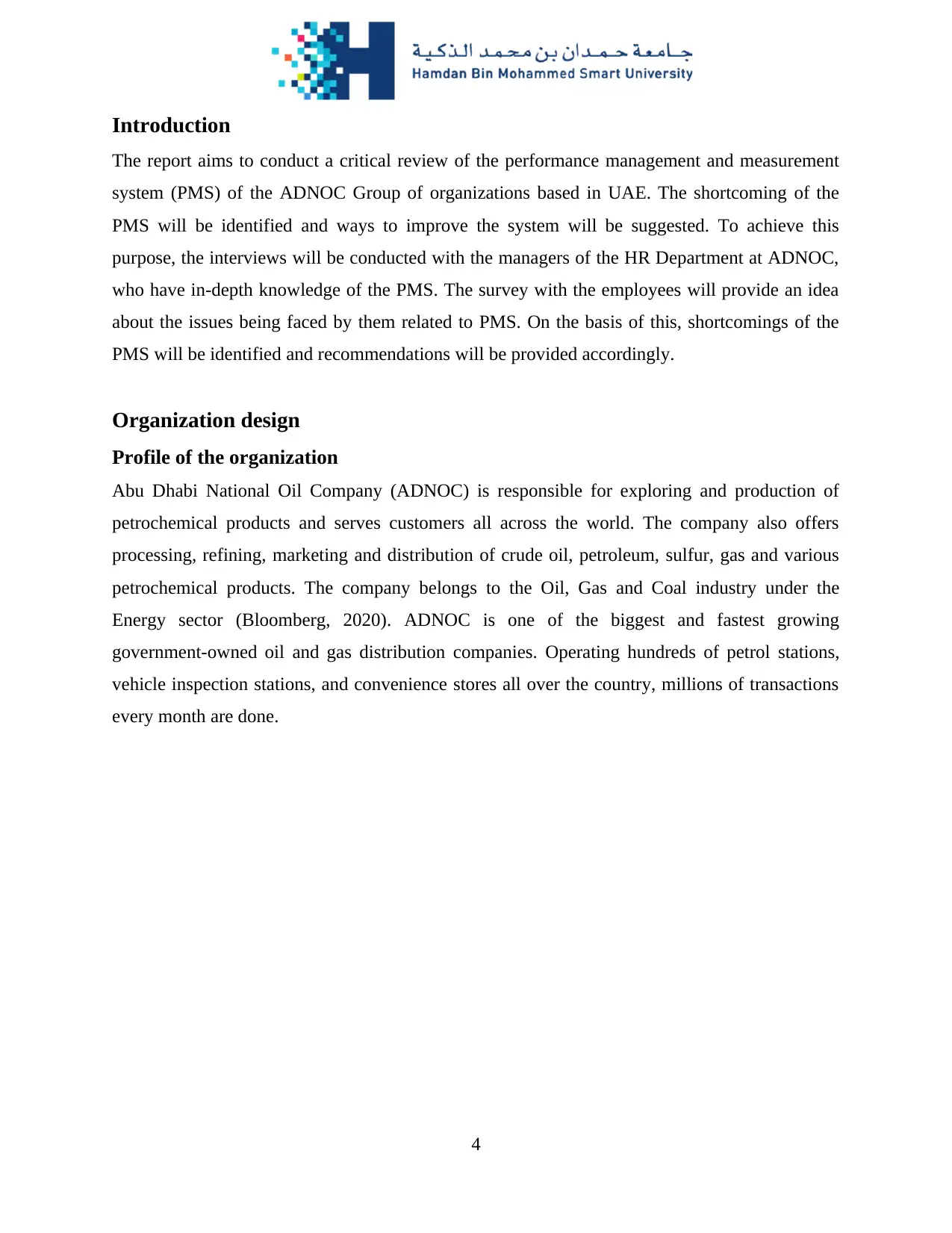
Introduction
The report aims to conduct a critical review of the performance management and measurement
system (PMS) of the ADNOC Group of organizations based in UAE. The shortcoming of the
PMS will be identified and ways to improve the system will be suggested. To achieve this
purpose, the interviews will be conducted with the managers of the HR Department at ADNOC,
who have in-depth knowledge of the PMS. The survey with the employees will provide an idea
about the issues being faced by them related to PMS. On the basis of this, shortcomings of the
PMS will be identified and recommendations will be provided accordingly.
Organization design
Profile of the organization
Abu Dhabi National Oil Company (ADNOC) is responsible for exploring and production of
petrochemical products and serves customers all across the world. The company also offers
processing, refining, marketing and distribution of crude oil, petroleum, sulfur, gas and various
petrochemical products. The company belongs to the Oil, Gas and Coal industry under the
Energy sector (Bloomberg, 2020). ADNOC is one of the biggest and fastest growing
government-owned oil and gas distribution companies. Operating hundreds of petrol stations,
vehicle inspection stations, and convenience stores all over the country, millions of transactions
every month are done.
4
The report aims to conduct a critical review of the performance management and measurement
system (PMS) of the ADNOC Group of organizations based in UAE. The shortcoming of the
PMS will be identified and ways to improve the system will be suggested. To achieve this
purpose, the interviews will be conducted with the managers of the HR Department at ADNOC,
who have in-depth knowledge of the PMS. The survey with the employees will provide an idea
about the issues being faced by them related to PMS. On the basis of this, shortcomings of the
PMS will be identified and recommendations will be provided accordingly.
Organization design
Profile of the organization
Abu Dhabi National Oil Company (ADNOC) is responsible for exploring and production of
petrochemical products and serves customers all across the world. The company also offers
processing, refining, marketing and distribution of crude oil, petroleum, sulfur, gas and various
petrochemical products. The company belongs to the Oil, Gas and Coal industry under the
Energy sector (Bloomberg, 2020). ADNOC is one of the biggest and fastest growing
government-owned oil and gas distribution companies. Operating hundreds of petrol stations,
vehicle inspection stations, and convenience stores all over the country, millions of transactions
every month are done.
4
Paraphrase This Document
Need a fresh take? Get an instant paraphrase of this document with our AI Paraphraser
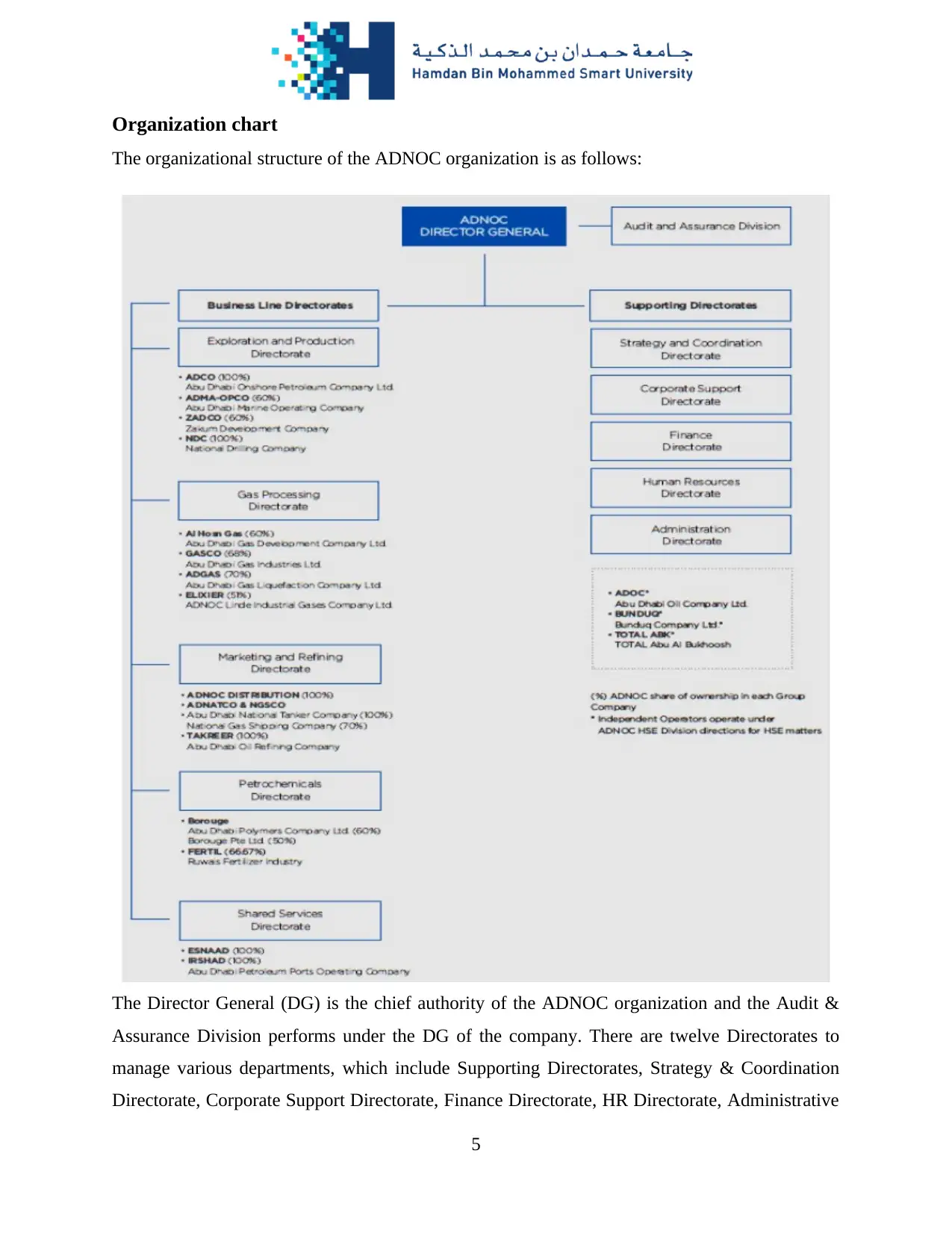
Organization chart
The organizational structure of the ADNOC organization is as follows:
The Director General (DG) is the chief authority of the ADNOC organization and the Audit &
Assurance Division performs under the DG of the company. There are twelve Directorates to
manage various departments, which include Supporting Directorates, Strategy & Coordination
Directorate, Corporate Support Directorate, Finance Directorate, HR Directorate, Administrative
5
The organizational structure of the ADNOC organization is as follows:
The Director General (DG) is the chief authority of the ADNOC organization and the Audit &
Assurance Division performs under the DG of the company. There are twelve Directorates to
manage various departments, which include Supporting Directorates, Strategy & Coordination
Directorate, Corporate Support Directorate, Finance Directorate, HR Directorate, Administrative
5
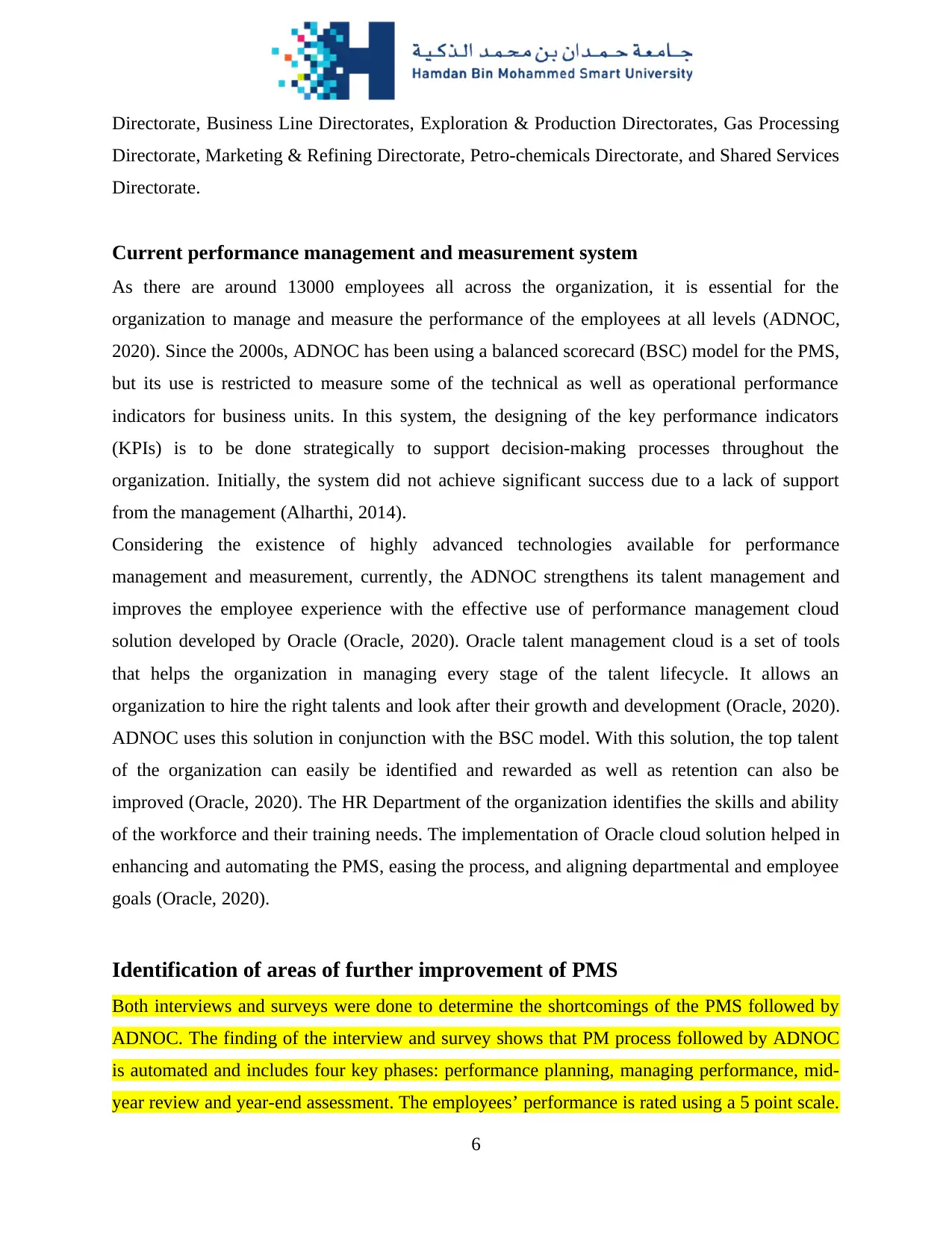
Directorate, Business Line Directorates, Exploration & Production Directorates, Gas Processing
Directorate, Marketing & Refining Directorate, Petro-chemicals Directorate, and Shared Services
Directorate.
Current performance management and measurement system
As there are around 13000 employees all across the organization, it is essential for the
organization to manage and measure the performance of the employees at all levels (ADNOC,
2020). Since the 2000s, ADNOC has been using a balanced scorecard (BSC) model for the PMS,
but its use is restricted to measure some of the technical as well as operational performance
indicators for business units. In this system, the designing of the key performance indicators
(KPIs) is to be done strategically to support decision-making processes throughout the
organization. Initially, the system did not achieve significant success due to a lack of support
from the management (Alharthi, 2014).
Considering the existence of highly advanced technologies available for performance
management and measurement, currently, the ADNOC strengthens its talent management and
improves the employee experience with the effective use of performance management cloud
solution developed by Oracle (Oracle, 2020). Oracle talent management cloud is a set of tools
that helps the organization in managing every stage of the talent lifecycle. It allows an
organization to hire the right talents and look after their growth and development (Oracle, 2020).
ADNOC uses this solution in conjunction with the BSC model. With this solution, the top talent
of the organization can easily be identified and rewarded as well as retention can also be
improved (Oracle, 2020). The HR Department of the organization identifies the skills and ability
of the workforce and their training needs. The implementation of Oracle cloud solution helped in
enhancing and automating the PMS, easing the process, and aligning departmental and employee
goals (Oracle, 2020).
Identification of areas of further improvement of PMS
Both interviews and surveys were done to determine the shortcomings of the PMS followed by
ADNOC. The finding of the interview and survey shows that PM process followed by ADNOC
is automated and includes four key phases: performance planning, managing performance, mid-
year review and year-end assessment. The employees’ performance is rated using a 5 point scale.
6
Directorate, Marketing & Refining Directorate, Petro-chemicals Directorate, and Shared Services
Directorate.
Current performance management and measurement system
As there are around 13000 employees all across the organization, it is essential for the
organization to manage and measure the performance of the employees at all levels (ADNOC,
2020). Since the 2000s, ADNOC has been using a balanced scorecard (BSC) model for the PMS,
but its use is restricted to measure some of the technical as well as operational performance
indicators for business units. In this system, the designing of the key performance indicators
(KPIs) is to be done strategically to support decision-making processes throughout the
organization. Initially, the system did not achieve significant success due to a lack of support
from the management (Alharthi, 2014).
Considering the existence of highly advanced technologies available for performance
management and measurement, currently, the ADNOC strengthens its talent management and
improves the employee experience with the effective use of performance management cloud
solution developed by Oracle (Oracle, 2020). Oracle talent management cloud is a set of tools
that helps the organization in managing every stage of the talent lifecycle. It allows an
organization to hire the right talents and look after their growth and development (Oracle, 2020).
ADNOC uses this solution in conjunction with the BSC model. With this solution, the top talent
of the organization can easily be identified and rewarded as well as retention can also be
improved (Oracle, 2020). The HR Department of the organization identifies the skills and ability
of the workforce and their training needs. The implementation of Oracle cloud solution helped in
enhancing and automating the PMS, easing the process, and aligning departmental and employee
goals (Oracle, 2020).
Identification of areas of further improvement of PMS
Both interviews and surveys were done to determine the shortcomings of the PMS followed by
ADNOC. The finding of the interview and survey shows that PM process followed by ADNOC
is automated and includes four key phases: performance planning, managing performance, mid-
year review and year-end assessment. The employees’ performance is rated using a 5 point scale.
6
⊘ This is a preview!⊘
Do you want full access?
Subscribe today to unlock all pages.

Trusted by 1+ million students worldwide
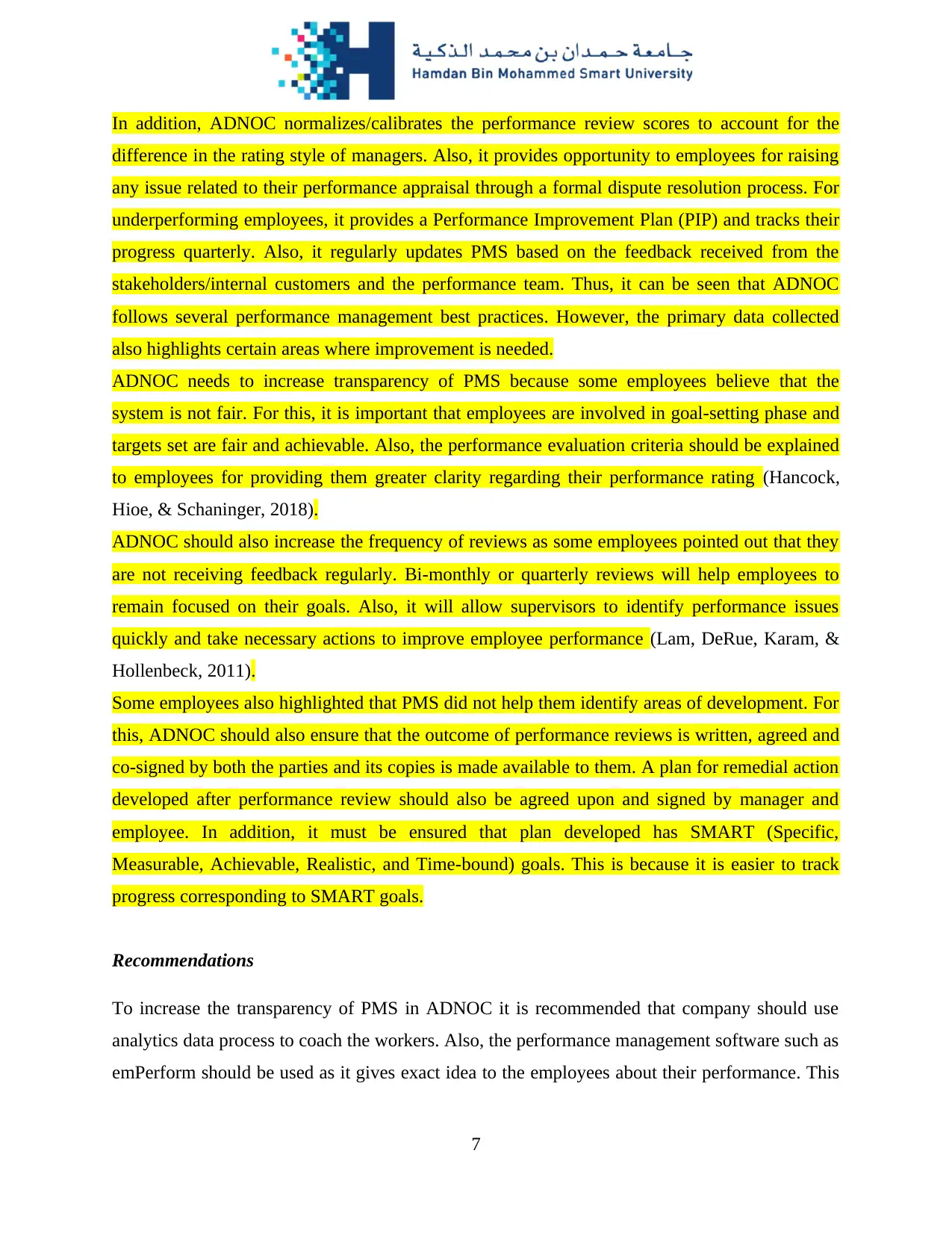
In addition, ADNOC normalizes/calibrates the performance review scores to account for the
difference in the rating style of managers. Also, it provides opportunity to employees for raising
any issue related to their performance appraisal through a formal dispute resolution process. For
underperforming employees, it provides a Performance Improvement Plan (PIP) and tracks their
progress quarterly. Also, it regularly updates PMS based on the feedback received from the
stakeholders/internal customers and the performance team. Thus, it can be seen that ADNOC
follows several performance management best practices. However, the primary data collected
also highlights certain areas where improvement is needed.
ADNOC needs to increase transparency of PMS because some employees believe that the
system is not fair. For this, it is important that employees are involved in goal-setting phase and
targets set are fair and achievable. Also, the performance evaluation criteria should be explained
to employees for providing them greater clarity regarding their performance rating (Hancock,
Hioe, & Schaninger, 2018).
ADNOC should also increase the frequency of reviews as some employees pointed out that they
are not receiving feedback regularly. Bi-monthly or quarterly reviews will help employees to
remain focused on their goals. Also, it will allow supervisors to identify performance issues
quickly and take necessary actions to improve employee performance (Lam, DeRue, Karam, &
Hollenbeck, 2011).
Some employees also highlighted that PMS did not help them identify areas of development. For
this, ADNOC should also ensure that the outcome of performance reviews is written, agreed and
co-signed by both the parties and its copies is made available to them. A plan for remedial action
developed after performance review should also be agreed upon and signed by manager and
employee. In addition, it must be ensured that plan developed has SMART (Specific,
Measurable, Achievable, Realistic, and Time-bound) goals. This is because it is easier to track
progress corresponding to SMART goals.
Recommendations
To increase the transparency of PMS in ADNOC it is recommended that company should use
analytics data process to coach the workers. Also, the performance management software such as
emPerform should be used as it gives exact idea to the employees about their performance. This
7
difference in the rating style of managers. Also, it provides opportunity to employees for raising
any issue related to their performance appraisal through a formal dispute resolution process. For
underperforming employees, it provides a Performance Improvement Plan (PIP) and tracks their
progress quarterly. Also, it regularly updates PMS based on the feedback received from the
stakeholders/internal customers and the performance team. Thus, it can be seen that ADNOC
follows several performance management best practices. However, the primary data collected
also highlights certain areas where improvement is needed.
ADNOC needs to increase transparency of PMS because some employees believe that the
system is not fair. For this, it is important that employees are involved in goal-setting phase and
targets set are fair and achievable. Also, the performance evaluation criteria should be explained
to employees for providing them greater clarity regarding their performance rating (Hancock,
Hioe, & Schaninger, 2018).
ADNOC should also increase the frequency of reviews as some employees pointed out that they
are not receiving feedback regularly. Bi-monthly or quarterly reviews will help employees to
remain focused on their goals. Also, it will allow supervisors to identify performance issues
quickly and take necessary actions to improve employee performance (Lam, DeRue, Karam, &
Hollenbeck, 2011).
Some employees also highlighted that PMS did not help them identify areas of development. For
this, ADNOC should also ensure that the outcome of performance reviews is written, agreed and
co-signed by both the parties and its copies is made available to them. A plan for remedial action
developed after performance review should also be agreed upon and signed by manager and
employee. In addition, it must be ensured that plan developed has SMART (Specific,
Measurable, Achievable, Realistic, and Time-bound) goals. This is because it is easier to track
progress corresponding to SMART goals.
Recommendations
To increase the transparency of PMS in ADNOC it is recommended that company should use
analytics data process to coach the workers. Also, the performance management software such as
emPerform should be used as it gives exact idea to the employees about their performance. This
7
Paraphrase This Document
Need a fresh take? Get an instant paraphrase of this document with our AI Paraphraser
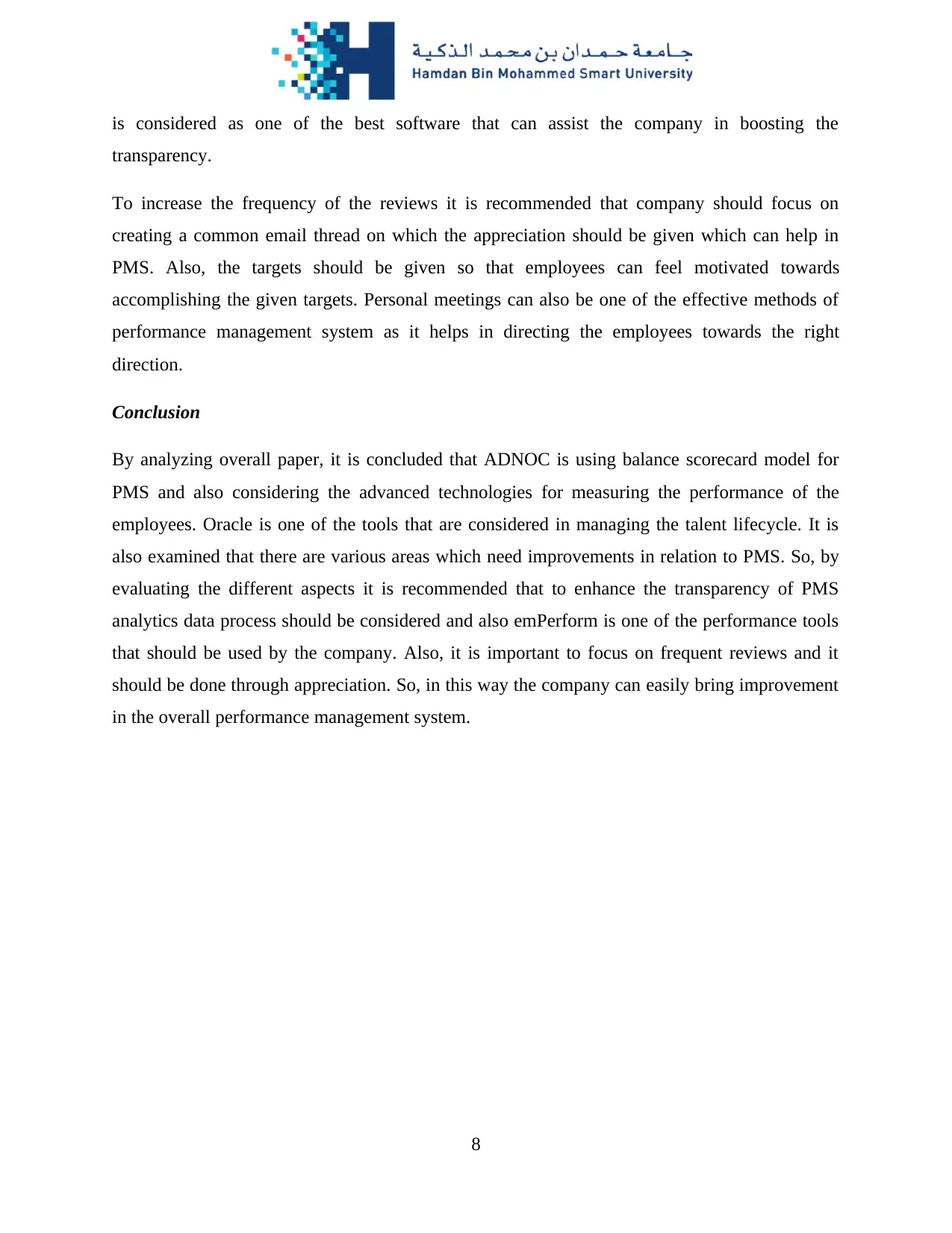
is considered as one of the best software that can assist the company in boosting the
transparency.
To increase the frequency of the reviews it is recommended that company should focus on
creating a common email thread on which the appreciation should be given which can help in
PMS. Also, the targets should be given so that employees can feel motivated towards
accomplishing the given targets. Personal meetings can also be one of the effective methods of
performance management system as it helps in directing the employees towards the right
direction.
Conclusion
By analyzing overall paper, it is concluded that ADNOC is using balance scorecard model for
PMS and also considering the advanced technologies for measuring the performance of the
employees. Oracle is one of the tools that are considered in managing the talent lifecycle. It is
also examined that there are various areas which need improvements in relation to PMS. So, by
evaluating the different aspects it is recommended that to enhance the transparency of PMS
analytics data process should be considered and also emPerform is one of the performance tools
that should be used by the company. Also, it is important to focus on frequent reviews and it
should be done through appreciation. So, in this way the company can easily bring improvement
in the overall performance management system.
8
transparency.
To increase the frequency of the reviews it is recommended that company should focus on
creating a common email thread on which the appreciation should be given which can help in
PMS. Also, the targets should be given so that employees can feel motivated towards
accomplishing the given targets. Personal meetings can also be one of the effective methods of
performance management system as it helps in directing the employees towards the right
direction.
Conclusion
By analyzing overall paper, it is concluded that ADNOC is using balance scorecard model for
PMS and also considering the advanced technologies for measuring the performance of the
employees. Oracle is one of the tools that are considered in managing the talent lifecycle. It is
also examined that there are various areas which need improvements in relation to PMS. So, by
evaluating the different aspects it is recommended that to enhance the transparency of PMS
analytics data process should be considered and also emPerform is one of the performance tools
that should be used by the company. Also, it is important to focus on frequent reviews and it
should be done through appreciation. So, in this way the company can easily bring improvement
in the overall performance management system.
8
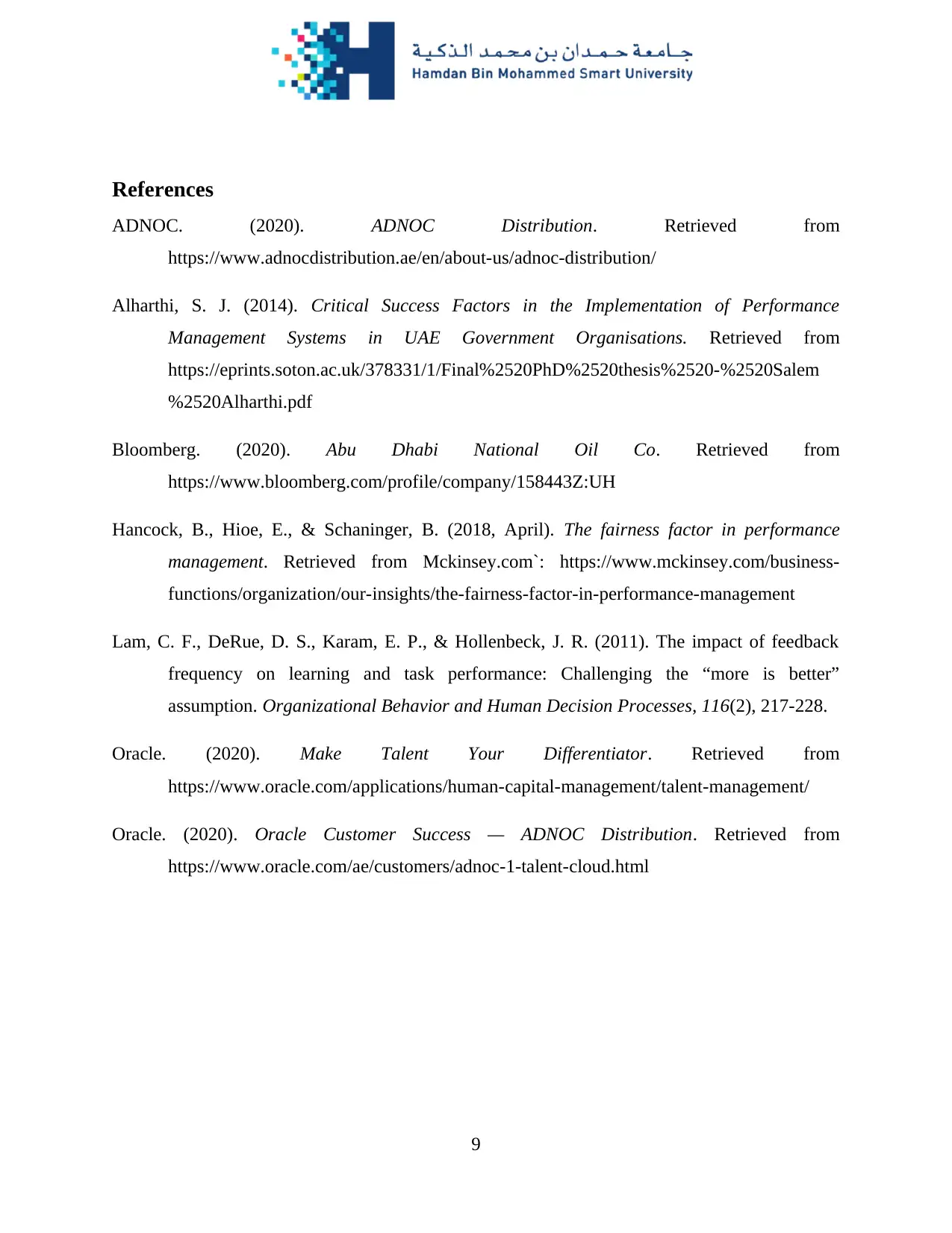
References
ADNOC. (2020). ADNOC Distribution. Retrieved from
https://www.adnocdistribution.ae/en/about-us/adnoc-distribution/
Alharthi, S. J. (2014). Critical Success Factors in the Implementation of Performance
Management Systems in UAE Government Organisations. Retrieved from
https://eprints.soton.ac.uk/378331/1/Final%2520PhD%2520thesis%2520-%2520Salem
%2520Alharthi.pdf
Bloomberg. (2020). Abu Dhabi National Oil Co. Retrieved from
https://www.bloomberg.com/profile/company/158443Z:UH
Hancock, B., Hioe, E., & Schaninger, B. (2018, April). The fairness factor in performance
management. Retrieved from Mckinsey.com`: https://www.mckinsey.com/business-
functions/organization/our-insights/the-fairness-factor-in-performance-management
Lam, C. F., DeRue, D. S., Karam, E. P., & Hollenbeck, J. R. (2011). The impact of feedback
frequency on learning and task performance: Challenging the “more is better”
assumption. Organizational Behavior and Human Decision Processes, 116(2), 217-228.
Oracle. (2020). Make Talent Your Differentiator. Retrieved from
https://www.oracle.com/applications/human-capital-management/talent-management/
Oracle. (2020). Oracle Customer Success — ADNOC Distribution. Retrieved from
https://www.oracle.com/ae/customers/adnoc-1-talent-cloud.html
9
ADNOC. (2020). ADNOC Distribution. Retrieved from
https://www.adnocdistribution.ae/en/about-us/adnoc-distribution/
Alharthi, S. J. (2014). Critical Success Factors in the Implementation of Performance
Management Systems in UAE Government Organisations. Retrieved from
https://eprints.soton.ac.uk/378331/1/Final%2520PhD%2520thesis%2520-%2520Salem
%2520Alharthi.pdf
Bloomberg. (2020). Abu Dhabi National Oil Co. Retrieved from
https://www.bloomberg.com/profile/company/158443Z:UH
Hancock, B., Hioe, E., & Schaninger, B. (2018, April). The fairness factor in performance
management. Retrieved from Mckinsey.com`: https://www.mckinsey.com/business-
functions/organization/our-insights/the-fairness-factor-in-performance-management
Lam, C. F., DeRue, D. S., Karam, E. P., & Hollenbeck, J. R. (2011). The impact of feedback
frequency on learning and task performance: Challenging the “more is better”
assumption. Organizational Behavior and Human Decision Processes, 116(2), 217-228.
Oracle. (2020). Make Talent Your Differentiator. Retrieved from
https://www.oracle.com/applications/human-capital-management/talent-management/
Oracle. (2020). Oracle Customer Success — ADNOC Distribution. Retrieved from
https://www.oracle.com/ae/customers/adnoc-1-talent-cloud.html
9
⊘ This is a preview!⊘
Do you want full access?
Subscribe today to unlock all pages.

Trusted by 1+ million students worldwide
1 out of 9
Your All-in-One AI-Powered Toolkit for Academic Success.
+13062052269
info@desklib.com
Available 24*7 on WhatsApp / Email
![[object Object]](/_next/static/media/star-bottom.7253800d.svg)
Unlock your academic potential
Copyright © 2020–2025 A2Z Services. All Rights Reserved. Developed and managed by ZUCOL.

